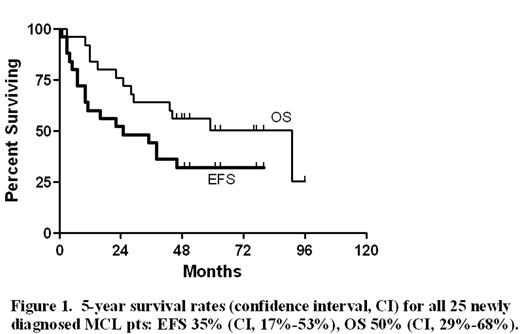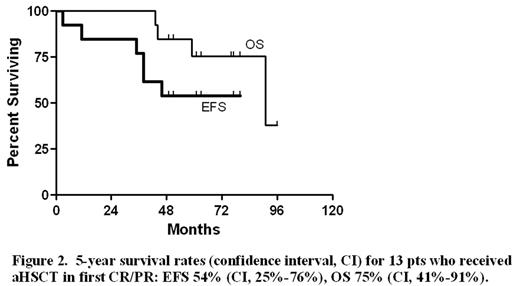Abstract
MCL is associated with high relapse rates and poor survival when treated with standard chemotherapy (chemoTx). We report long-term outcomes with intent-to-treat (ITT) analysis of a prospective phase II protocol of intensive induction chemoTx, followed by HSCT in first complete or partial remission (CR/PR). MCL diagnosis was based on histology with cyclin D1+ or CCND1/IGH fusion. Induction chemoTx consisted of cyclophosphamide 1.5 gm/m2, teniposide 100 mg/m2, and doxorubicin 50 mg/m2 all given day 1 and prednisone 100 mg/m2 days 1–5 (CTAP); this was followed by vincristine 1.4 mg/m2 and methotrexate 3.0 gm/m2 on day 21 and cytarabine 3.0 gm/m2 × 2 doses 12 hours apart day 22 (VMAC). Patients (pts) who achieved CR/PR after 2 cycles CTAP/VMAC (1 cycle=42 days) received 1 additional cycle. Pts ≤ age 65 then proceeded to aHSCT, while pts < 50 with a matched sibling donor had allogeneic HSCT, both with busulfan/cyclophosphamide200 conditioning. After aHSCT, pts received maintenance αinterferon/interleukin-2 (αIFN/IL-2) given together QD Monday-Friday every other month (mos) × 3 mos (both dosed at 3×106 IU/m2). Responding pts > age 65 proceeded directly to αIFN/IL-2 after 3 cycles chemoTx. 25 newly diagnosed MCL pts were entered onto trial from 2/97 through 11/02. Median age was 57 (range 39–76; 16M/9F); 83% had bone marrow involvement, and 32% had other extranodal disease at diagnosis. On ITT analysis, overall response rate (ORR) was 68% after chemoTx (CR 28%/PR 40%). 17 pts received HSCT (13 autologous and 4 allogeneic); 4 eligible pts did not proceed to transplant due to progressive disease. Following HSCT, ORR was 77%. There were no treatment-related deaths. 5 pts experienced reversible non-hematologic grade 4 toxicities (2 bilirubin, 1 stomatitis, 1 infection, and 1 renal failure). On ITT, 5-year EFS and OS for all pts is 35% and 50%, respectively (Figure 1). With a median follow-up of 61 mos, 5-year EFS and OS for pts who received aHSCT is 54% and 75%, respectively (Figure 2). This includes 7/13 aHSCT pts who are alive and disease free at 49, 51, 61, 63, 61, 77, and 80 mos. Patients who received aHSCT had significantly improved survival compared to pts who received allogeneic or no HSCT (p=0.003 EFS and p=0.001 OS by logrank test). We conclude that CTAP/VMAC induction chemoTx followed by aHSCT in first remission for newly diagnosed MCL results in durable EFS and OS. Incorporation of monoclonal antibody and other novel targeted agents should further improve pt outcomes.
5-year survival rates (confidence interval, CI) for all 25 newly diagnosed MCL pts: EFS 35% (CI, 17%–53%), OS 50% (CI, 29%–68%).
5-year survival rates (confidence interval, CI) for all 25 newly diagnosed MCL pts: EFS 35% (CI, 17%–53%), OS 50% (CI, 29%–68%).
5-year survival rates (confidence interval, CI) for 13 pts who received aHSCT in first CR/PR: EFS 54% (CI, 25%–76%), OS 75% (CI, 41%–91%).
5-year survival rates (confidence interval, CI) for 13 pts who received aHSCT in first CR/PR: EFS 54% (CI, 25%–76%), OS 75% (CI, 41%–91%).
Disclosure: No relevant conflicts of interest to declare.
Author notes
Corresponding author



This feature is available to Subscribers Only
Sign In or Create an Account Close Modal